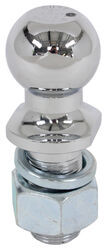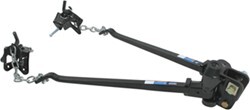
Recommendation for WD/Sway Control for 2007 Fleetwood Saratoga and 2010 Ford Flex
Question:
Patrick, Here are the answers to your questions. This is from the Flex owners manual: ------------------------------------------------------ For towing trailers up to 3500 lb (1588 kg), use a weight carrying hitch and ball which uniformly spreads the trailer tongue loads through the vehicle underbody structure. For towing trailers over 3500 lb (1588 kg), up to 4500 lb (2042 kg), it is recommended to use a weight distributing hitch to increase front axle load while towing. Hitches Do not use hitches that clamp onto the vehicle bumper. Use a load carrying hitch. You must distribute the load in your trailer so that 10–15 percent of the total weight of the trailer is on the tongue. Weight distributing hitch When hooking up a trailer using a load equalizing hitch, always use the following procedure: 1. Park the unloaded vehicle on a level surface. With the ignition on and all doors closed, allow the vehicle to stand for several minutes so that it can level. 2. Measure the height of a reference point on the front and rear bumpers at the center of the vehicle. 3. Attach the trailer to the vehicle and adjust the hitch equalizers so that the front bumper height is within 1/2 inch (13 mm) of the reference point. After proper adjustment, the rear bumper should be no higher than in Step 2. WARNING: Do not adjust a weight distributing hitch to any position where the rear bumper of the vehicle is higher than it was before attaching the trailer. Doing so will defeat the function of the weight distributing hitch, which may cause unpredictable handling, and could result in serious personal injury. -------------------------------------------------------------- The tow length is 17 feet 3 inches. This Flex came from the factory with the Class III tow package, pre-wired for brake controller, and had built in sway control (must be part of the traction control system)
asked by: Ken G
Expert Reply:
Tongue weight will depend on how you load it. I would check the Flex owners manual to see what the weight distribution capacity of the vehicle is. Some vehicles cannot use weight distribution systems. I am not sure on the Flex, but to be safe, I would strongly recommend checking the owners manual.
Some of the aftermarket hitches we have do allow use of weight distribution system and some do not. The ones that do, do not allow an increase in tow capacity. So I would imagine if your factory hitch cane be used with WD, it will still be limited to 450 pounds tongue weight.
The way to determine what weight distribution system you need is to establish the loaded tongue weight of the trailer. Loaded tongue weight can be estimated as 10-15 percent of the gross loaded trailer weight.
Since the GVRW of the trailer is 3500 pounds, that means the trailer cannot weigh more than that when fully loaded. That puts the tongue weight, when properly loaded within capacity limits, at 350 to 525 pounds. Assuming the WD can be used and you will be limited to 450 pounds tongue weight, you should use a weight distribution system with a tongue weight range of 100-600 pounds that way your tongue weight falls in the middle.
I know all this info may be a bit confusing, but I can help you work it out and recommend a specific kit or two. I will just need some more info from you first. Let me know what you find in the vehicle owners manual about use of weight distribution. Let me know the length of the trailer, this will help us determine if you need sway control and what kind.

Products Referenced in This Question
2-5/16" Hitch Ball - 1-1/4" Diameter x 2-3/4" Long Shank - Chrome - 12,000 lbs
- Trailer Hitch Ball
- Trailer Hitch Ball
- Standard Ball
- Chrome-Plated Steel
- 2-5/16 Inch Diameter Ball
- 2-3/4 Inch Shank Length
- 1-1/4 Inch Diameter Shank
- 12000 lbs GTW
- Class IV
- Class V
- Draw-Tite
more information >
2" Hitch Ball - 1-1/4" Diameter x 2-5/8" Long Shank - Chrome - 10,000
- Trailer Hitch Ball
- Trailer Hitch Ball
- Standard Ball
- Chrome-Plated Steel
- 2 Inch Diameter Ball
- 2-5/8 Inch Shank Length
- 1-1/4 Inch Diameter Shank
- 10000 lbs GTW
- Class IV
- Class V
- CURT
more information >
Convert-A-Ball Cushioned Weight Distribution Shank for 2" Hitches - 10,000 lbs
- Accessories and Parts
- Weight Distribution Hitch
- Shanks
- Fits 2 Inch Hitch
- Round - 3 Inch Drop
- Trunnion - 2 Inch Drop
- Round - 6 Inch Rise
- Trunnion - 7 Inch Rise
- Convert-A-Ball
more information >
Strait-Line Weight Distribution w/ Sway Control - No Shank - Trunnion Bar - 6K GTW, 600 lbs TW
- Weight Distribution Hitch
- WD With Sway Control
- Some Sway
- Shank Not Included
- Electric Brake Compatible
- Fits 2 Inch Hitch
- Fits 2-1/2 Inch Hitch
- Allows Backing Up
- 300 lbs
- 400 lbs
- 500 lbs
- Reese
more information >











Ken G.
7/13/2010
Patrick, Here are the answers to your questions. This is from the Flex owners manual: ------------------------------------------------------ For towing trailers up to 3500 lb (1588 kg), use a weight carrying hitch and ball which uniformly spreads the trailer tongue loads through the vehicle underbody structure. For towing trailers over 3500 lb (1588 kg), up to 4500 lb (2042 kg), it is recommended to use a weight distributing hitch to increase front axle load while towing. Hitches Do not use hitches that clamp onto the vehicle bumper. Use a load carrying hitch. You must distribute the load in your trailer so that 10–15 percent of the total weight of the trailer is on the tongue. Weight distributing hitch When hooking up a trailer using a load equalizing hitch, always use the following procedure: 1. Park the unloaded vehicle on a level surface. With the ignition on and all doors closed, allow the vehicle to stand for several minutes so that it can level. 2. Measure the height of a reference point on the front and rear bumpers at the center of the vehicle. 3. Attach the trailer to the vehicle and adjust the hitch equalizers so that the front bumper height is within 1/2 inch (13 mm) of the reference point. After proper adjustment, the rear bumper should be no higher than in Step 2. WARNING: Do not adjust a weight distributing hitch to any position where the rear bumper of the vehicle is higher than it was before attaching the trailer. Doing so will defeat the function of the weight distributing hitch, which may cause unpredictable handling, and could result in serious personal injury. -------------------------------------------------------------- The tow length is 17 feet 3 inches. This Flex came from the factory with the Class III tow package, pre-wired for brake controller, and had built in sway control (must be part of the traction control system)